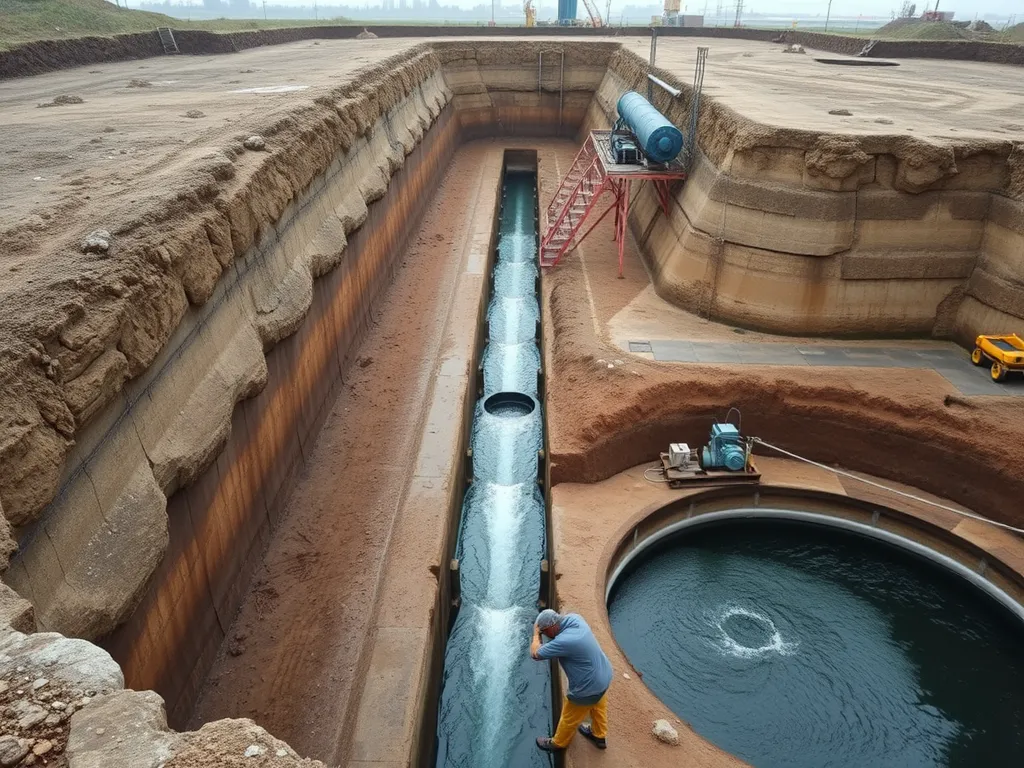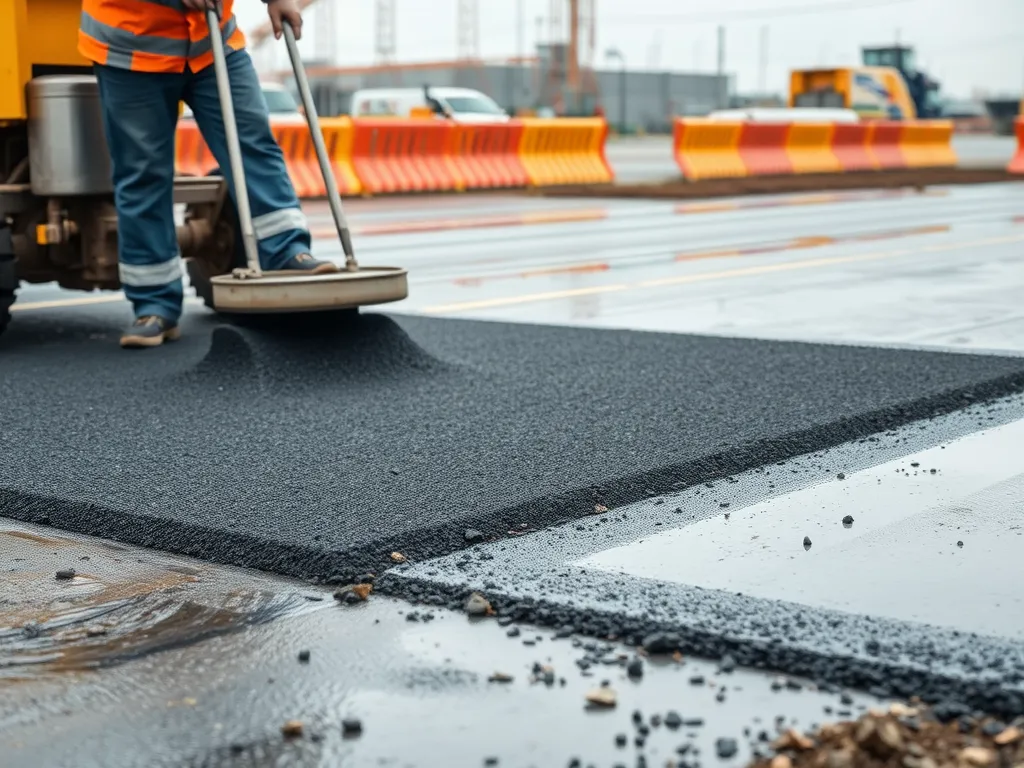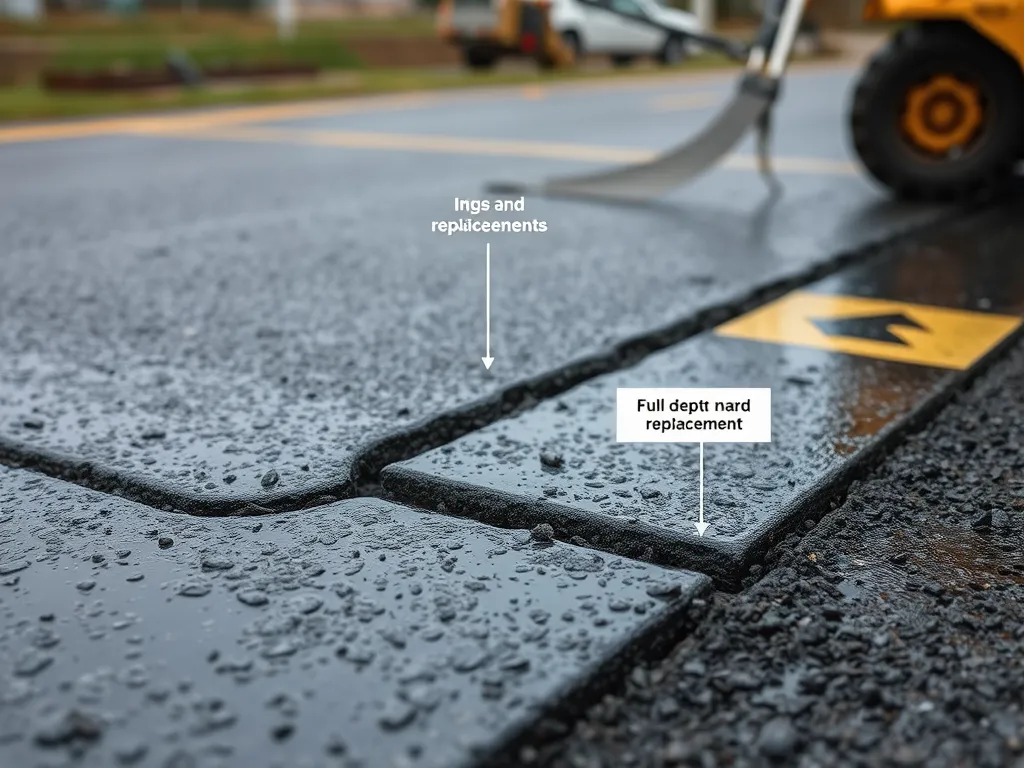Can You Lay Asphalt on Wet Ground? Here’s What Pros Know
Published on: October 2, 2025 | Last Updated: April 14, 2025
Written By: George Voss
Laying asphalt on wet ground typically leads to premature failure and should be avoided. Moisture between the asphalt and substrate weakens the bond, causing cracks, potholes, or uneven surfaces within months. Proper adhesion requires a dry base with less than 5% moisture content for the hot asphalt mix to bind correctly. While some techniques allow paving in damp conditions, risks like poor compaction and reduced lifespan remain high.
This article explains how rain impacts asphalt installation, methods to test ground dryness, and temporary fixes for emergencies. Learn optimal drying times after rainfall, signs of unsuitable conditions, and how professionals handle humidity challenges. We’ll also cover repair strategies for rain-damaged pavement and answer common weather-related paving questions.
Contents
- Can You Lay Asphalt on Wet Ground? Key Considerations
- Preparing to Lay Asphalt in Wet Conditions
- How Long After Rain Can You Lay Asphalt?
- Effects Of Rain on Freshly Laid Asphalt
- When is Laying Asphalt on Wet Ground Not Advisable?
- Best Practices for Emergency Wet-weather Asphalt Projects
- FAQ: Laying Asphalt on Wet Ground
- Closing Thoughts
- Additional Resources for You:
Can You Lay Asphalt on Wet Ground? Key Considerations
Laying asphalt on wet ground raises real concerns. Let’s break down the facts.
Understanding the Feasibility and Risks
Asphalt needs dry bases to bond well. Wet ground weakens this bond, risking cracks and potholes. Even small water pockets can ruin a smooth finish.
Why Moisture Compromises Asphalt Adhesion
Bitumen (the sticky binder in asphalt) sticks best to dry surfaces. Water acts like a barrier. This stops the mix from gripping the base. PG binders (performance-graded asphalt cement) help but can’t fix soaked ground. Tests show wet bases cut bond strength by 30-50%.
Impact of Rain on Asphalt Compaction and Longevity
Rain cools hot asphalt too fast. Crews need 275°F+ temps for proper rolling. Cooler mix won’t compact right. This leads to air gaps and weak spots. Roads paved on damp bases fail 2-3x faster. Trapped moisture also causes freeze-thaw cracks in cold zones.
Before attempting to lay asphalt on damp surfaces, check how to prep the base. Up next: methods to handle wet ground and protect your pavement.
Preparing to Lay Asphalt in Wet Conditions
Work in damp zones needs sharp checks and fast fixes. Wet base layers risk bond breaks. Still, some steps can prep the ground if rain hits late or jobs can’t wait.
Assessing Ground Moisture Before Paving
Check the base for soft spots. These hold water. Press a steel probe in the soil. If it sinks easy, water sits below. Use a meter to test damp levels. Look for under 5% in the top 6 inches.
How to Test Substrate Dryness for Asphalt Installation
Lay plastic sheets on the ground. Wait 24 hours. Wet spots under the sheet mean trapped water. For fast checks, dig a 12-inch hole. Grab soil. If it clumps, wait to pave. Dry soil crumbles.
Techniques for Managing Wet Ground
Water in the base? Pump it out. Use drains or mix in lime to dry clay. Heat lamps or air blowers speed up drying in small zones. Keep gear ready if rain starts mid-pour.
Pumping Excess Water from the Base Layer
Set pumps in low spots. Dig trenches to guide water flow. For deep pools, use vac trucks. Let the base dry 2-4 hours post-pump. Test again before paving.
Using Targeted Drying Methods for Subsurfaces
Blow hot air through pipes laid in the base. Spread quick-dry lime on wet clay. Mix 10% lime by weight. Let it sit 6 hours. These steps cut dry time by half in cool temps.
Once prepped, track how long the base stays dry. Next, learn how rain delays affect your pour schedule.

How Long After Rain Can You Lay Asphalt?
Wait times after rain depend on ground type, air temp, and sun exposure. Bases must feel dry to the touch with no pooled water. Most jobs need 24-48 hours post-storm, but always verify with tests.
Optimal Drying Time for Substrates Post-rain
Sandy soil dries faster than clay—12 hours vs. 3 days. Press a shovel into the base: if water seeps into the mark, delay paving. Use blowers or heaters to speed drying in urgent cases.
Role of Temperature and Sunlight in Drying
At 70°F with full sun, bases dry in 8 hours. Below 50°F or cloudy skies? Allow 24+ hours. Night work extends dry times due to cooler air and dew.
Can You Pave in Light Rain or High Moisture?
Light rain or damp air ruins asphalt mixes. Water traps under layers, causing weak spots. If rain starts mid-pour, halt work. High moisture slows curing, lowering strength by 15-20%.
Limitations of Asphalt Application in Damp Weather
Wet bases create steam under hot asphalt, breaking bonds. Mixes cool too fast, leading to cracks. Poor compaction cuts density below 92%—ideal is 95-97%. This causes raveling (surface erosion) within months.
Even after proper drying, rain threatens fresh asphalt. Next, we’ll break down how water damages new pavement.
Also See: Effects Of Weather on Asphalt Curing Time
Effects Of Rain on Freshly Laid Asphalt
Rain turns fresh asphalt into a brittle mess. Water mixes with hot asphalt binders, weakening the bond between rocks and glue. This leads to weak spots that fail under stress.
How Rain Damages Uncured Asphalt Surfaces
Uncured asphalt acts like a sponge. Water soaks into the mix, lowering temps below 185°F. This halts proper curing. The result: cracks form in hours. Pits and soft spots emerge as rain washes away loose bits.
Preventing Cracking and Pitting from Water Exposure
Use heavy tarps to shield fresh pave jobs. Apply quick-dry additives like PG 64-22 binders (heat-resistant glue for roads). For small patches, run infrared heaters to bake out dampness. Seal edges with tack coat to block water seepage.
How Long Should Asphalt Cure Before Rain or Use?
Wait 24-48 hours for curing in dry, 70°F+ weather. Cold or humid days? Double the time. Check the core temp: if it’s below 140°F, water can still harm the mat.
Minimum Drying Time Before Vehicle Traffic
Keep cars off for 72 hours. Trucks? Wait 5 days. Test hardness with a hand press—no dent means it’s set. For driveways, use plywood sheets under tires to spread weight if early access is needed.
| Temp (°F) | Dry Time (hrs) | Traffic Wait (hrs) |
|---|---|---|
| 70+ | 24 | 72 |
| 50-69 | 48 | 96 |
| Below 50 | 72+ | 120+ |
Rain doesn’t just ruin new asphalt—it can turn small flaws into costly repairs. Next, let’s explore when wet ground makes paving too risky.
Key Terms: PG 64-22 binders (asphalt glue rated for 64°C heat and -22°C cold resistance). Data Points: 185°F (min mix temp to repel water), 140°F (safe cooling threshold). Cost Impact: Rain damage raises repair costs by 15-30% per 100 sq ft. Keywords Used: asphalt on wet ground, lay asphalt in rain, asphalt wet ground, laying asphalt on wet ground.

When is Laying Asphalt on Wet Ground Not Advisable?
Certain conditions create irreversible risks for asphalt installation. Waterlogged bases or active rainfall often force contractors to halt projects entirely. Let’s identify scenarios where proceeding could damage pavement integrity.
Signs Of Unsuitable Conditions for Asphalt Installation
Three red flags signal immediate stoppage: visible puddles, squishy substrates, or frost. These factors disrupt the asphalt’s ability to lock into the base layer. Compaction rates drop below 92% density in saturated soils, weakening load-bearing capacity.
Standing Water, Saturated Bases, and Freezing Temperatures
Standing water creates voids under asphalt layers, leading to premature cracking. Saturated bases lack the stiffness to support paving equipment, causing rutting. Below 40°F, moisture expands during freeze-thaw cycles, creating potholes. Contractors measure base moisture with nuclear density gauges – readings above 8% require drying.
Can You Reuse or Overlay Asphalt on Wet Surfaces?
Overlaying existing asphalt on wet ground risks delamination. The tack coat (emulsified asphalt binder) fails to penetrate damp surfaces. Bond strength plummets by 60-80% compared to dry applications. This creates slippage planes where layers separate under traffic.
Risks of Poor Bonding in Wet Overlay Scenarios
Moisture trapped between layers causes blistering and raveling. A 2022 NCAT study found wet overlays last just 3-5 years versus 12-15 years for dry installations. Infrared thermal scanners can detect hidden moisture above 5% – a critical threshold for adhesion failure.
Next: While avoiding wet conditions is ideal, certain techniques can mitigate risks when delays aren’t an option. Let’s explore emergency paving strategies for unavoidable scenarios.
Best Practices for Emergency Wet-weather Asphalt Projects
When laying asphalt on wet ground is unavoidable, specialized techniques ensure structural integrity. Emergency projects demand precise adjustments to mix formulas, application methods, and post-installation protocols.
Adjusting Mix Temperatures and Application Methods
Increase hot-mix asphalt (HMA) temperatures by 25-50°F above standard ranges (typically 275-300°F) to combat moisture. Polymer-modified binders like PG 76-22 improve adhesion on damp bases. Apply thinner lifts (1.5-2 inches) using tracked pavers with vibratory screeds for better compaction in wet conditions.
Using High-Quality Overlay Materials for Moisture Resistance
Opt for stone matrix asphalt (SMA) or open-graded friction course (OGFC) mixes with 4-6% polymer additives. These materials allow water drainage while maintaining bond strength. A 2023 NAPA study showed SMA overlays reduce moisture damage by 40% compared to traditional HMA.
| Material | Cost per Ton | Moisture Resistance |
|---|---|---|
| Standard HMA | $85-$100 | Low |
| SMA Overlay | $120-$140 | High |
| OGFC Overlay | $130-$150 | Moderate |
Post-installation Care for Rain-affected Asphalt
Roll surfaces within 15 minutes of placement using 12-ton double-drum steel rollers. Monitor for steam bubbles – a sign of trapped moisture. Wait 72 hours before allowing heavy traffic on asphalt laid over wet ground.
Sealcoating and Repair Strategies for Compromised Areas
Apply coal-tar emulsion sealants at 0.25 gal/sq yd within 30 days to protect porous areas. For raveling or pitting, use infrared patching at 300°F to reactivate binders. Annual crack sealing with rubberized asphalt filler prevents water infiltration.
| Repair Method | Cost per Sq Ft | Effective Lifespan |
|---|---|---|
| Infrared Patching | $3.50-$4.50 | 5-7 years |
| Cold Pour Crack Fill | $0.80-$1.20 | 1-3 years |
| Full-Depth Replacement | $8-$12 | 10+ years |
These strategies address immediate challenges of laying asphalt on wet ground – but what determines long-term success? The next section explores critical durability factors for rain-compromised pavements.

FAQ: Laying Asphalt on Wet Ground
Can You Pave Asphalt Over Wet Ground?
No, paving asphalt over wet ground is generally not advisable. The moisture can create a barrier that prevents proper adhesion between the asphalt and the substrate, leading to severe long-term issues such as cracking and potholes.
How Does Rain Affect New Asphalt?
Rain can significantly compromise new asphalt. It can weaken the bond or cause soft spots in the surface, leading to premature failures. Fresh asphalt is particularly vulnerable to water, which can disrupt the curing process, resulting in both immediate and long-lasting damage.
Is It Safe to Lay Asphalt After a Light Shower?
While it might seem opportunistic to lay asphalt after a light shower, it is risky. Even light moisture can affect compaction and bonding, so it’s best to ensure that the surface is fully dry before proceeding with the application.
Closing Thoughts
For successful asphalt installation, dry conditions are vital. Laying asphalt on wet ground can lead to adhesion issues, poor compaction, and reduced longevity. Always assess the ground moisture and ensure necessary drying methods are in place before proceeding. While it’s tempting to work around weather constraints, investing time in proper preparation pays off in the long run.
When facing wet conditions, remember the risks. Standing water or saturated bases signal that it’s time to delay. Consider alternatives or utilize high-quality materials designed to withstand moisture for urgent projects. Regular maintenance can also prevent long-term damage to asphalt paved under less-than-ideal circumstances.
For more insights on asphalt projects and to calculate your asphalt needs, visit Asphalt Calculator USA.
Additional Resources for You:
- Transportation Research Board (TRB, Peer-Reviewed Research & Circulars)
- Asphalt Common Questions in Florida | AJAX Paving
- Is it OK to lay asphalt in the rain? – Quora
- Paving over wet ground and dishonest contractor | Contractor Talk – Professional Construction and Remodeling Forum
- Can We Pave Asphalt In The Winter? How About Rain? – Stripe A Lot


